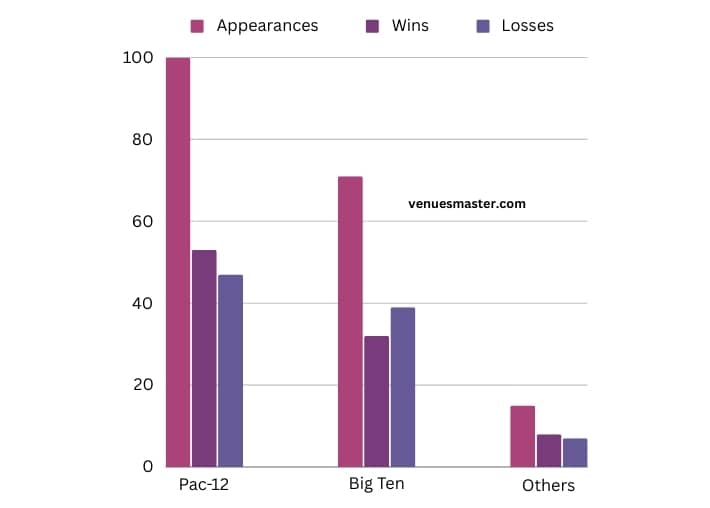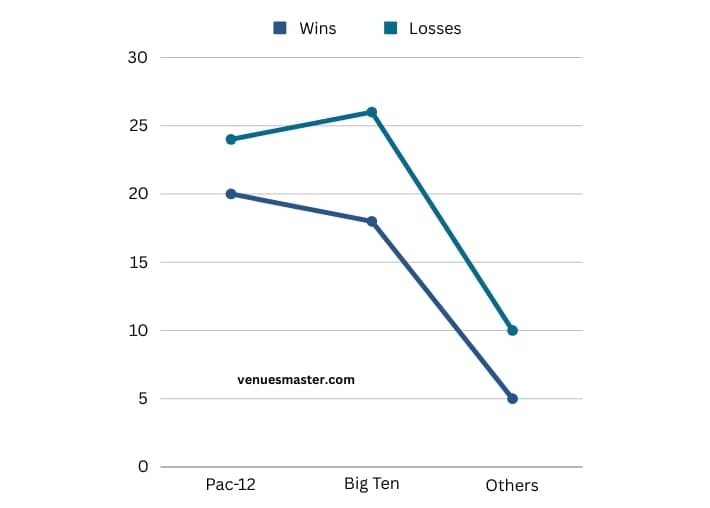Published on: 30 December 2023
Written by Najrul / Fact-checked by Asma Abir
The Rose Bowl predominantly features teams from the Big Ten and Pac-12 conferences. In years when it’s not a College Football Playoff (CFP) semifinal, champions from these conferences are usually the participants.
The Rose Bowl, steeped in tradition and history, is more than just a college football game; it’s a cultural phenomenon that has been celebrated annually since 1902. Originally, it was a matchup between the Pacific Coast Conference, now known as the Pac-12, and the Big Ten Conference.
This tradition has largely continued, with the Rose Bowl often being referred to as the “Granddaddy of Them All” due to its prestige and history. The integration of the Rose Bowl into the CFP system has introduced a new dynamic to team selection.
In years when the Rose Bowl serves as a CFP semifinal, teams are chosen based on their national CFP rankings, allowing for participation from across various conferences. This change ensures that the Rose Bowl remains a key player in the evolving landscape of college football, balancing its rich history with the modern competitive spirit of the sport.
The game not only signifies a successful season for the participating teams but also marks a place in the annals of college football history, cherished by players and fans alike.

What Conferences Play in the Rose Bowl?
Rose Bowl Teams: A Historical Journey
The Rose Bowl, often referred to as ‘The Granddaddy of Them All’, has a rich history marked by memorable teams and games. This prestigious college football event, first played in 1902, has seen a multitude of teams from various conferences vying for glory. Initially, the game featured a matchup between the Pacific Coast Conference (now the Pac-12) and the Big Ten Conference.
Over the years, these conferences have had a significant presence in the game. The evolution of team selection, influenced by the Bowl Championship Series (BCS) and later the College Football Playoff (CFP), has opened the doors for teams from other conferences to participate. This evolution reflects the changing landscape of college football, where merit and performance have gradually taken precedence over traditional conference ties.
Rose Bowl Participation by Conference (1902-2023)
| Conference | Appearances | Wins | Losses |
| Pac-12 | 100 | 53 | 47 |
| Big Ten | 71 | 32 | 39 |
| Others | 15 | 8 | 7 |

Conference Influence on Rose Bowl Selections
The selection process for the Rose Bowl has been significantly influenced by conference affiliations. Historically, the game predominantly featured teams from the Pac-12 and Big Ten conferences.
With the advent of the BCS and the CFP, the selection criteria have evolved, allowing teams from other conferences to participate under certain conditions. This shift has been a result of conference realignment and the performance of teams in major conferences. The inclusion of at-large bids and the establishment of a playoff system have further diversified the pool of teams, making the Rose Bowl more inclusive and competitive.
This evolution reflects the dynamic nature of college football, where performance and rankings have become crucial in determining bowl game selections.
Comparative Success in the Rose Bowl
The Rose Bowl’s history is marked by varying degrees of success among participating conferences. The Pac-12 and Big Ten have traditionally dominated the game, but recent years have seen a more diverse set of winners. A comparative analysis of win-loss records reveals interesting trends and shifts in dominance.
For instance, the Pac-12 has historically had a slight edge over the Big Ten, but this gap has narrowed in recent years. The introduction of teams from other conferences has added a new dimension to the competition, challenging the traditional powerhouses.
Rose Bowl Win-Loss Record by Conference (1980-2023)
| Conference | Wins | Losses |
| Pac-12 | 20 | 24 |
| Big Ten | 18 | 26 |
| Others | 5 | 10 |

Economic and Cultural Impact of the Rose Bowl
The Rose Bowl’s impact extends beyond the field, significantly influencing the economies and cultures of the participating conferences. The game generates substantial revenue through ticket sales, sponsorships, and broadcasting rights, benefiting the conferences and their respective institutions.
The Rose Bowl has a profound cultural impact, fostering a sense of pride and tradition among fans and alumni. The media coverage of the event further amplifies its significance, making it a staple in American college football culture. This economic and cultural significance underscores the importance of the Rose Bowl in shaping the landscape of college football.
Future of Conferences in the Rose Bowl Era
Looking ahead, the landscape of college football and the role of conferences in the Rose Bowl are poised for potential changes. The evolving dynamics of college football, including playoff expansion and conference realignment, could alter the traditional structure of the Rose Bowl.
Emerging teams and conferences are challenging the status quo, creating a more competitive environment. These changes, coupled with the ongoing debate over playoff implications and the selection process, suggest a future where adaptability and performance will be key for conferences aspiring to participate in the Rose Bowl.
FAQs
How Are Teams Selected for the Rose Bowl?
The selection of teams for the Rose Bowl is a process governed by the College Football Playoff (CFP) system. In years when the Rose Bowl is not a CFP semifinal, the game traditionally hosts the champions of the Big Ten and Pac-12 conferences.
If the champion from either conference is selected for the CFP, the Rose Bowl usually invites the next highest-ranked team from that conference. This process ensures that the Rose Bowl maintains its historic connection with the Big Ten and Pac-12, while also adapting to the modern playoff format.
What Role Does the CFP Play in Rose Bowl Selections?
The College Football Playoff (CFP) has a significant impact on the selection of teams for the Rose Bowl. When the Rose Bowl serves as a CFP semifinal, the teams are chosen based on their CFP rankings, irrespective of their conference.
This means that in CFP years, teams from any conference, including those outside the Big Ten and Pac-12, can compete in the Rose Bowl. This integration with the CFP adds a layer of national competitiveness to the Rose Bowl, distinguishing it from its traditional conference ties.
Are Non-Big Ten or Pac-12 Teams Eligible for the Rose Bowl?
Yes, teams from outside the Big Ten and Pac-12 conferences can play in the Rose Bowl, especially in years when it serves as a CFP semifinal. In these instances, the selection is based on the CFP rankings, allowing top teams from any conference to participate.
In non-CFP years, if the Big Ten or Pac-12 champion qualifies for the CFP, the Rose Bowl may invite a non-champion or a team from a different conference to fill the vacant spot, ensuring a competitive matchup.
What Time Will the Rose Bowl 2024 Kick Off in Mountain Time?
The Rose Bowl 2024 time kick off in Mountain Time is scheduled for early evening. Football fans in the Mountain Time Zone can catch the much-anticipated game at the appointed rose bowl 2024 time without having to worry about time zone differences.
What Is the Frequency of the Rose Bowl Hosting CFP Semifinals?
The Rose Bowl hosts College Football Playoff (CFP) semifinals on a rotational basis. Typically, this occurs every three years. During these years, the selection of teams is based solely on CFP rankings, regardless of their conference affiliation. This rotation is part of a broader system involving other major bowl games, ensuring that each of these prestigious events gets an opportunity to host a semifinal, thereby maintaining their significance in the college football landscape.
How Has Conference Realignment Affected the Rose Bowl?
Conference realignment has had a notable impact on the Rose Bowl, particularly in terms of team selection and traditional matchups. As conferences have expanded and shifted, the traditional ties between the Rose Bowl and the Big Ten and Pac-12 conferences have been challenged.
Realignment can lead to changes in the strength and competitiveness of conferences, which in turn affects which teams are eligible for the Rose Bowl, especially in non-CFP years. This dynamic landscape requires the Rose Bowl to adapt while trying to preserve its historic connections.
What Is the Historical Significance of the Rose Bowl for Participating Teams?
The Rose Bowl holds immense historical significance for participating teams, often seen as a pinnacle of college football achievement. For many teams, especially those in the Big Ten and Pac-12, playing in the Rose Bowl is a coveted goal, steeped in tradition and prestige.
It represents not just a successful season, but also a place in the rich tapestry of college football history. The game’s long-standing tradition, dating back to 1902, adds to its allure, making it a cherished destination for college football teams across the nation.
In summary, the Rose Bowl’s history and its impact on college football are as diverse as they are significant. From its traditional conference ties to the evolving selection process and its economic and cultural influence, the Rose Bowl remains a pivotal event in college sports. As the landscape of college football continues to evolve, so too will the role and significance of conferences in this storied bowl game.




